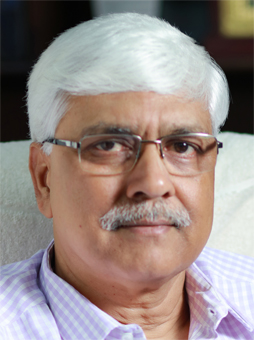
The IEEE Region 10 Symposium
Symposium Theme: Technological Innovation for Humanity
7-9 June 2019, at Kolkata, India
Tutorial on - Artificial Intelligence and Data Science
Speaker: Prof. Pabitra Mitra
Dept. of Computer Science & Engg.
IIT Kharagpur
Non-Invasive Monitoring of Transformer Insulation by Time and Frequency Domain Methods
Dr. Sivaji Chakravorti
Director, NIT Calicut
(Professor of Electrical Engineering, Jadavpur University-On Lien)
Email: s_chakravorti@ieee.org
URL: www.schakravorti.info
Director, NIT Calicut
(Professor of Electrical Engineering, Jadavpur University-On Lien)
Email: s_chakravorti@ieee.org
URL: www.schakravorti.info

Abstract:
Large section of the power infrastructure in developed as well as developing countries is
getting old. Significant numbers of equipment are nearing their designed end of life or have
already exceeded it. Such equipment that is still in operation is very much prone to failures.
In the context of the deregulated market economy, utilities are forced to optimize asset
utilization by operating existing infrastructure at ever-higher capacity levels, in many cases,
exceeding nameplate ratings in order to defer capital investment in new facilities or in the
refurbishment of existing facilities. Thus, most of the power utilities have focused their
efforts on developing methods to assess the condition of capital intensive infrastructure in
order to optimize capital investment.
Reliable diagnostic tool for condition monitoring of capital intensive infrastructure such as transformers is also important from the point of view of reduction in maintenance cost. Currently, power utilities are either shifting or have shifted from traditional Time Based Maintenance (TBM) to Condition Based Maintenance (CBM). This is due to the fact that in CBM, equipment will be maintained only if it is needed. On the other hand, in TBM often equipment is maintained when it is not required and often maintenance is not carried out when it is required.
The main aim of modern condition monitoring procedure is to carry out non-invasive diagnostics through terminal measurements. There is considerable focus on developing tools to diagnose aging effects of capital intensive infrastructure, such as power transformers, non- destructively and reliably in the field. In this context, chemical techniques were used conventionally. New electrical techniques have been developed and are being put to use in the last decade, which claim to offer reliable diagnostics.
The speaker is carrying out advanced research work for a long time in the area of assessing the condition of oil-paper insulation of transformers based on the studies of changes in the dielectric properties of insulating materials with aging. The results and techniques developed have been published in international journals including IEEE Transactions. This tutorial is based on the experiences gathered in the course of such research works and covers the following topics:
i) Two methods in time-domain, viz.
Polarization and Depolarization Current Measurement (PDC)
Recovery Voltage Measurement (RVM)
ii) The third method in frequency domain, viz.
Frequency Domain Spectroscopy (FDS)
Reliable diagnostic tool for condition monitoring of capital intensive infrastructure such as transformers is also important from the point of view of reduction in maintenance cost. Currently, power utilities are either shifting or have shifted from traditional Time Based Maintenance (TBM) to Condition Based Maintenance (CBM). This is due to the fact that in CBM, equipment will be maintained only if it is needed. On the other hand, in TBM often equipment is maintained when it is not required and often maintenance is not carried out when it is required.
The main aim of modern condition monitoring procedure is to carry out non-invasive diagnostics through terminal measurements. There is considerable focus on developing tools to diagnose aging effects of capital intensive infrastructure, such as power transformers, non- destructively and reliably in the field. In this context, chemical techniques were used conventionally. New electrical techniques have been developed and are being put to use in the last decade, which claim to offer reliable diagnostics.
The speaker is carrying out advanced research work for a long time in the area of assessing the condition of oil-paper insulation of transformers based on the studies of changes in the dielectric properties of insulating materials with aging. The results and techniques developed have been published in international journals including IEEE Transactions. This tutorial is based on the experiences gathered in the course of such research works and covers the following topics:
i) Two methods in time-domain, viz.
Polarization and Depolarization Current Measurement (PDC)
Recovery Voltage Measurement (RVM)
ii) The third method in frequency domain, viz.
Frequency Domain Spectroscopy (FDS)
Brief Profile of the Speaker:
Dr. Sivaji Chakravorti (SM 2000) did his BEE, MEE and PhD from Jadavpur University,
Kolkata, India, in 1983, 1985 and 1993, respectively. From 1985 he is a full-time faculty
member of Electrical Engineering Department of Jadavpur University, where he is currently
Professor in Electrical Engineering. Since Aug 2015, he is the Director of National Institute
of Technology Calicut on lien from Jadavpur University. He worked at the Technical
University Munich as Humboldt Research Fellow in 1995-96, 1999 and 2007, respectively.
He served as Development Engineer in Siemens AG in Berlin in 1998. He has also worked as
Humboldt Research Fellow in ABB Corporate Research at Ladenburg, Germany, in 2002. He
worked as US-NSF guest scientist at the Virginia Tech, USA, in 2003 and as guest scientist at
Technical University Hamburg-Harburg, Germany, in 2005. He is the recipient of Technical
University Munich Ambassador Award in 2013 and AICTE Technology Day Award in 2003.
He is Fellow of Indian National Academy of Engineering, Fellow of National Academy of
Sciences India and Distinguished Lecturer of IEEE Power and Energy Society. He was an
Associate Editor of IEEE Transactions on Dielectrics & Electrical Insulation. He has
published more than 185 research papers including 60 papers in IEEE Transactions, authored
three books, edited three books, developed three online courses and owns one US patent, two
Indian patents and two software copyrights. His current fields of interest are condition
monitoring of power equipment, numerical field computation and optimization of insulation
system.